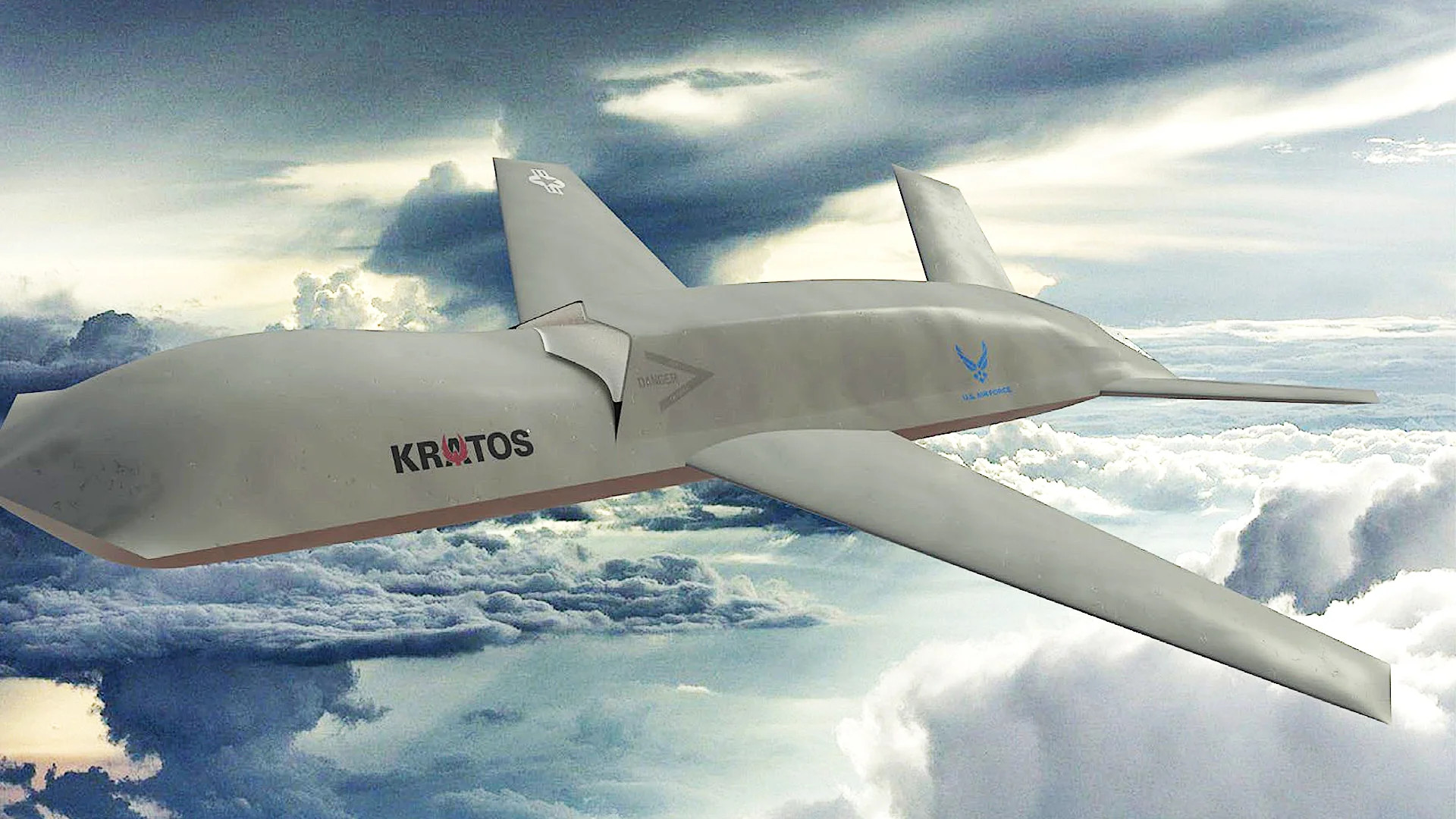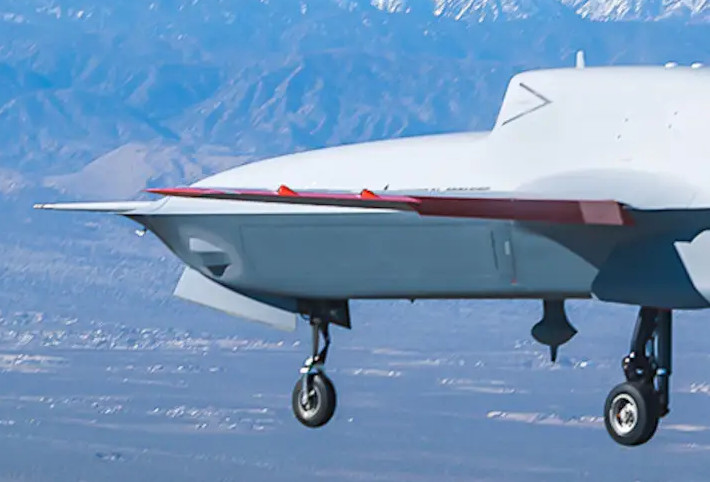The U.S. Air Force has disclosed substantial new details about its secretive Off-Board Sensing Station program, or OBSS, and related developments. This comes after the drone developed under OBSS, General Atomics’ XQ-67A, took its first flight. We now know about the existence of a previously undisclosed companion drone, with higher performance and weapons deployment capabilities, called the Off-Board Weapon Station, although the exact status of that aircraft remains unknown.
The Air Force Research Laboratory announced the first flight of the XQ-67A earlier today. The War Zone was the first to report on the unveiling of this drone, and you can learn more about what was and wasn’t previously known about the design and the OBSS program in our initial feature here.

Prior to today, details about OBSS and its goals have been very limited. AFRL has now disclosed that the program is an evolution of its Low Cost Attritable Aircraft Technologies (LCAAT) initiative, which dates back to 2014.
“We’ve been evolving this class of systems since the start of the Low Cost Attritable Aircraft Technologies initiative,” Doug Meador, an autonomous collaborative platform capability lead in AFRL’s Aerospace Systems Directorate, said in the Air Force’s press release about the XQ-67A’s first flight. “We broke it down according to how the warfighter sees these put together: autonomy, human systems integration, sensor and weapons payloads, networks and communications, and the air vehicle.”
LCAAT notably led to the Low Cost Attritable Strike Demonstrator (LCASD) project under which the Air Force acquired its first XQ-58 Valkyrie drones from Kratos. Since 2019, Air Force XQ-58s, which the service is now calling a first generation of autonomous collaborative platform (ACP), have been used in an array of advanced uncrewed and other testing efforts. The U.S. Marine Corps is now also flying XQ-58s in support of its own drone initiatives.

OBSS more directly sprung from another program within LCAAT called Low Cost Attritable Aircraft Platform Sharing (LCAAPS). OBSS has also leveraged experience from the LCASD project, according to AFRL.
“We had always intended from the start of LCAAT to have multiple vehicle development spirals or threads of vehicle development,” Trenton White, OBSS program manager and aerospace engineer at AFRL’s Aerospace Systems Directorate, who is also the program manager for LCAAPS, also said in the XQ-67A first flight release. “Then once the vehicle is proven ready, you can start integrating stuff with it, such as sensors, autonomy, weapons, payloads, and electronics.”
In 2018, LCAAPS’ focus shifted to “can we provide the acquirer with a new way of buying aircraft that is different and better and quicker than the old traditional way of how we build manned aircraft?” according to Meador. “Which means we pretty much start over from scratch every time.”
“It’s really about leveraging this best practice that we’ve seen in the automotive and other industries where time to market has decreased, while the time to initial operating capability for military aircraft has increased at an alarming rate,” White said. “The main objectives here are to validate an open aircraft system concept for hardware and software and to demonstrate rapid time-to-market and low development cost.”
We now know that OBSS was actually one of two more specific LCAAPS concepts to emerge. The other was called the Off-Board Weapon Station (OBWS). “The OBSS was viewed as slower while carrying sensors but have longer endurance, while the OBWS was considered faster and more maneuverable, with less endurance but better range,” according to AFRL.

“This approach will help save time and money by leveraging standard substructures and subsystems, similar to how the automotive industry builds a product line,” Meador explained. “From there, the genus can be built upon for other aircraft – similar to that of a vehicle frame – with the possibility of adding different aircraft kits to the frame, such as an Off-Board Sensing Station or Off-Board Weapon Station.”
AFRL’s release indicates at least some work on OBSS and OBWS was done in parallel. However, it’s unclear if the OBWS concept has also turned into a flying reality, like OBSS, or even if it remains deep in development, although the AFRL certainly didn’t make it sound like it was abandoned in its release. It is unknown what company or companies might have been contracted to develop an actual OBWS air vehicle if that program was also pursued to the same ends as OBSS.
A ‘killer’ companion to OBSS’s ‘hunter’ does make good sense, as would acquiring functional examples of both that could work together, even on an experimental basis. It would really better explain why OBSS exists at all, as it seemed a bit peculiar all on its own. Having these two drones, which may even share a common core, to experiment with together could be a major leap forward in proving that modular concept (more on that in a moment) and just exploring the possibilities of such an uncrewed teaming effort.
The War Zone has reached out to AFRL for more information about OBWS and its current status.
It also remains unknown what sensor or sensors the OBSS program expects the XQ-67A to carry. The War Zone has explored in the past how infrared search and track (IRST) systems, the benefits of which you can read more about here, would seem to be in line with what is known about its intended air-to-air mission set.
From what we have now seen of the XQ-67A, the drone has what could be large side-looking airborne radar (SLAR) apertures on both sides of the forward fuselage. These could also be weapons bays, but this would make less sense for that particular location and would not be in line with what we understand OBSS is intended to do. Working as a forward radar node, capable of aerial and surface/ground surveillance, would certainly be a capability worth exploring and fits with what we know about the Air Force’s future ‘distributed’ aerial radar surveillance aspirations.

Regardless, as already noted, a core element of OBSS is developing an uncrewed aircraft design around a common “chassis” that could then be used as the basis for other drones.
OBSS’ underlying common chassis/core concept is also fully in line with General Atomics’ description of its Gambit family of drones, which it first unveiled in 2022. To date, the company has not formally drawn a direct connection between Gambit and OBSS (and now the XQ-67A).
However, as The War Zone noted when the XQ-67A was unveiled, there have been many indications that the two developments are interconnected. The XQ-67A looks virtually identical to one of the notional Gambit designs General Atomics has put forward in the past and it fits perfectly with the company’s big bet on this broader modular concept.

General Atomics has Gambit derivative concepts, that use the same core ‘chassis’ that would potentially fulfill the OBWS requirement. The Gambit concepts that sit above OBSS in terms of performance could suit such a requirement, and doing so would really prove the modular concept AFRL is talking about. In fact, it’s worth mentioning that prior to today, the Gambit modular approach seemed unique to General Atomics. Now we know that the AFRL was specifically chasing this concept and funded the OBSS and the OBWS to do it.
In addition, the new details AFRL has now shared about OBSS and LCAAPS clearly speak to the concepts of “affordable mass” and “speed-to-ramp” that are critical to the Air Force’s Collaborative Combat Aircraft (CCA) program. At the most basic level, affordable mass refers to a desire for lower-cost options to help create the large volumes of combat capacity that would be required for any future major conflict, such as one in the Pacific against China. Speed-to-ramp refers then to the kinds of design, development, and manufacturing practices to help acquire that affordable mass. You can read more about these concepts here.
“This is all part of a bigger plan and it’s all about this affordable mass,” Meador said. “This has to be done affordably and this program – even though there’s an aircraft at the end that we’re going to get a lot of use out of – the purpose of this program was the journey of rapid, low-cost production as much as it was the destination of a relevant combat aircraft.”
Just like LCAAPS, iterative development of multiple types of drones with potentially dramatically different designs is also central to the CCA program.
Overall, AFRL is looking to send “signals to other companies that there is a new approach to constructing an aircraft, moving away from the conventional method of starting from scratch,” according to Meador.
“We don’t have the time and resources to do that,” he added. “We have to move quicker now.”

Overall, OBSS looks more and more like it is at least a related exploratory effort running in parallel to the CCA program, and one that could be a key stepping stone for the latter to achieve its ambitious goals. The potential existence of an armed, higher-performance drone developed under OBWS, or at least the exploration of such a design, would also align with the CCA effort.
The big question at this point is does the OBWS exist or is it planned to be built, and who is doing so? If General Atomics is involved with the OBWS as well, then their Gambit concept may be far more mature than anyone outside of the realms of classification previously thought. On the other hand, if another firm is heading up the OBWS effort, another modular chassis concept is out there, as well as a higher-performance advanced airframe to sit on it.
Contact the author: joe@twz.com
